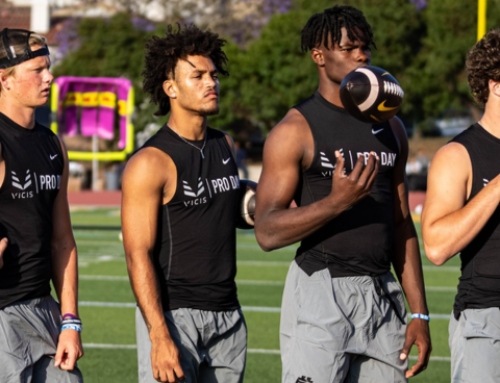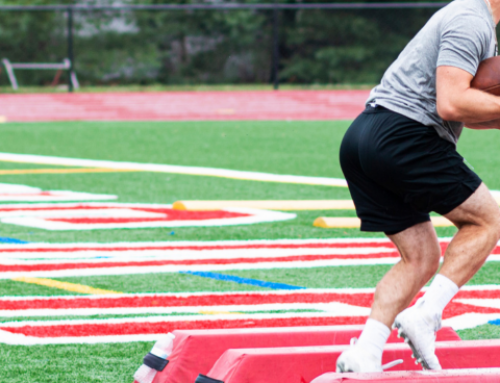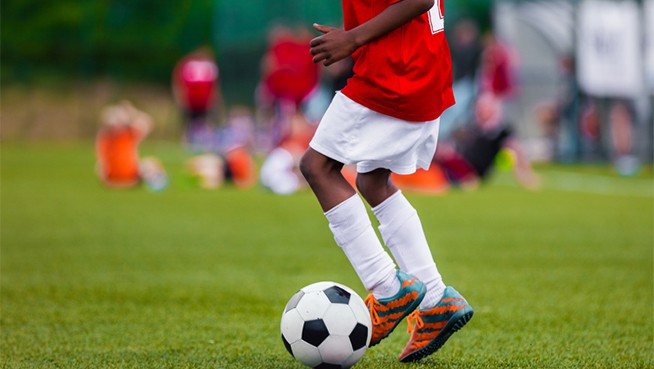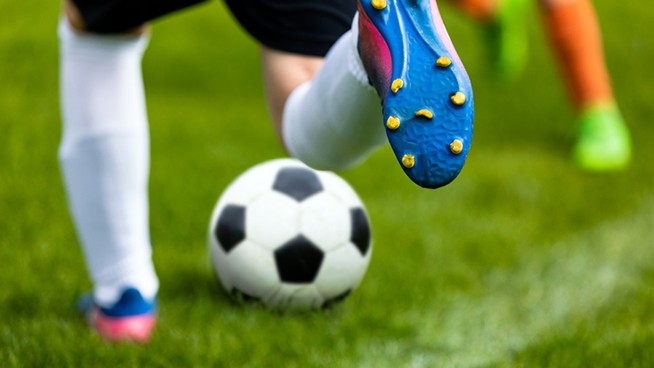Improve Throwing Velocity With These Five Exercises
Baseball players and football quarterbacks need to improve their throwing velocity throughout their careers. Quarterbacks must be able to fire a perfect spiral to a wide receiver; pitchers always need a heater; and infielders and outfielders need cannon arms to throw out runners. By adding slight alterations to exercises you are probably already doing, you can train to throw faster.
How to Increase Pitching Velocity
Tricep Pushdown are great for throwing athletes, because the tricep is the muscle most activated when the ball is released. Personal trainer and wellness coach Kevin Rail says, “The triceps sit on the back of the upper arms and extend to the elbows, which is what happens when you straighten your arm.” The straightened arm at the end of a Tricep Pushdown simulates the end of a throwing motion, making it an ideal exercise to build strength and, therefore, improve throwing velocity.
The video above shows LSU Football players performing Tricep Pushdowns.
Tricep Pushdown
- Vary tricep exercises from week to week
- Use different handles throughout sets
- Get full range of motion and control the movement
- Keep elbows tight to sides
- Avoid using momentum
Sets/Reps: 3×10
Cable External Rotations, which engage the small grouping of muscles around the shoulder joint, will help you throw with velocity for an extended period of time. Rail instructs, “Bend your left elbow 90 degrees and rest your upper arm against your side. Your left forearm should be out in front of your stomach at this point. Keeping your upper arm still, rotate your forearm out to your left side as far as possible. Slowly move it back in, repeat for a set of reps and switch sides.” Use the video above as a visual guide.
Cable External Rotation
Next up: Walking Lunge With Med Ball Twists. “A lunge works the glutes, quadriceps and hamstrings, which all need to be strong to repetitively push off [the ground] during a game,” notes Rail. Including a Med Ball Twist with the Lunge also works the core, which generates force during a throw.
Begin with feet shoulder-width apart while holding a medicine ball away from your chest. “Keeping your back straight, take a step forward with your right foot and lower yourself into a lunge by bending both knees,” says Rail. “As you do this, twist your torso to the right side as far as possible as you move the ball. Twist yourself back to a forward position, stand back up and repeat the whole sequence on your other side. Continue to alternate back and forth.”
Watch Brandon Roy perform a slightly different version of this exercise.
Brandon Roy Resistance Band Walking Lunge With Med Ball Rotation
The Plank is another exercise that develops stability in the core, helping to prevent injury and providing more force production for hard throws. Assume the Push-Up position, lower your forearms to the floor and hold. Engage your obliques with Side Planks. Oilers’ Shawn Horcoff takes you through a Plank series above.
Shawn Horcoff Plank Series
Finally, the Bicycle Crunch works the entire abdominal area in one motion, simulating how the body moves during a throw. “Begin in a face-up position on the floor with your legs lifted, knees bent 90 degrees and hands on the sides of your head,” instructs Rail. “Steadily raise your shoulders and head from the floor and look at your thighs. Move your left elbow and right knee toward each other as you extend your left leg, then quickly reverse your direction. Continue to alternate back and forth in a steady motion.” To intensify this exercise, add ankle weights.
New York Red Bulls Bicycle Crunch
To improve throwing velocity, strengthen your core as well as your arm. The exercises above will help you build strength in the triceps, rotator cuff and core. Perform three sets three times per week for noticeable results.
Source: Livestrong.com
RECOMMENDED FOR YOU
Improve Throwing Velocity With These Five Exercises
Baseball players and football quarterbacks need to improve their throwing velocity throughout their careers. Quarterbacks must be able to fire a perfect spiral to a wide receiver; pitchers always need a heater; and infielders and outfielders need cannon arms to throw out runners. By adding slight alterations to exercises you are probably already doing, you can train to throw faster.
How to Increase Pitching Velocity
Tricep Pushdown are great for throwing athletes, because the tricep is the muscle most activated when the ball is released. Personal trainer and wellness coach Kevin Rail says, “The triceps sit on the back of the upper arms and extend to the elbows, which is what happens when you straighten your arm.” The straightened arm at the end of a Tricep Pushdown simulates the end of a throwing motion, making it an ideal exercise to build strength and, therefore, improve throwing velocity.
The video above shows LSU Football players performing Tricep Pushdowns.
Tricep Pushdown
- Vary tricep exercises from week to week
- Use different handles throughout sets
- Get full range of motion and control the movement
- Keep elbows tight to sides
- Avoid using momentum
Sets/Reps: 3×10
Cable External Rotations, which engage the small grouping of muscles around the shoulder joint, will help you throw with velocity for an extended period of time. Rail instructs, “Bend your left elbow 90 degrees and rest your upper arm against your side. Your left forearm should be out in front of your stomach at this point. Keeping your upper arm still, rotate your forearm out to your left side as far as possible. Slowly move it back in, repeat for a set of reps and switch sides.” Use the video above as a visual guide.
Cable External Rotation
Next up: Walking Lunge With Med Ball Twists. “A lunge works the glutes, quadriceps and hamstrings, which all need to be strong to repetitively push off [the ground] during a game,” notes Rail. Including a Med Ball Twist with the Lunge also works the core, which generates force during a throw.
Begin with feet shoulder-width apart while holding a medicine ball away from your chest. “Keeping your back straight, take a step forward with your right foot and lower yourself into a lunge by bending both knees,” says Rail. “As you do this, twist your torso to the right side as far as possible as you move the ball. Twist yourself back to a forward position, stand back up and repeat the whole sequence on your other side. Continue to alternate back and forth.”
Watch Brandon Roy perform a slightly different version of this exercise.
Brandon Roy Resistance Band Walking Lunge With Med Ball Rotation
The Plank is another exercise that develops stability in the core, helping to prevent injury and providing more force production for hard throws. Assume the Push-Up position, lower your forearms to the floor and hold. Engage your obliques with Side Planks. Oilers’ Shawn Horcoff takes you through a Plank series above.
Shawn Horcoff Plank Series
Finally, the Bicycle Crunch works the entire abdominal area in one motion, simulating how the body moves during a throw. “Begin in a face-up position on the floor with your legs lifted, knees bent 90 degrees and hands on the sides of your head,” instructs Rail. “Steadily raise your shoulders and head from the floor and look at your thighs. Move your left elbow and right knee toward each other as you extend your left leg, then quickly reverse your direction. Continue to alternate back and forth in a steady motion.” To intensify this exercise, add ankle weights.
New York Red Bulls Bicycle Crunch
To improve throwing velocity, strengthen your core as well as your arm. The exercises above will help you build strength in the triceps, rotator cuff and core. Perform three sets three times per week for noticeable results.
Source: Livestrong.com










